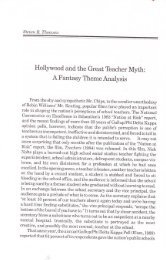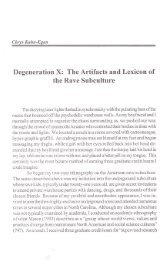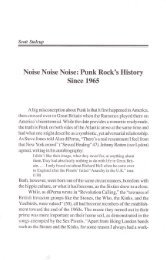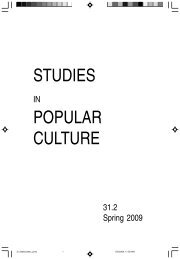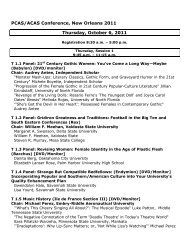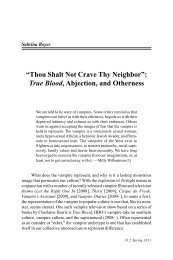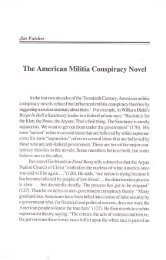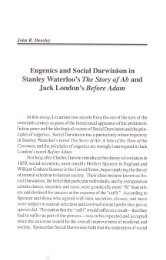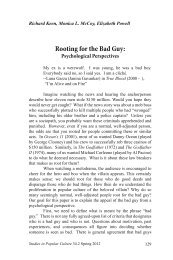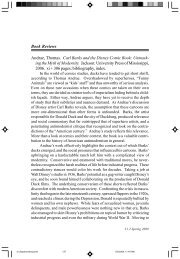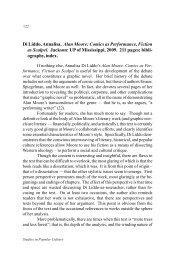The Jesus Fish: Evolution of a Cultural Icon - Popular/American ...
The Jesus Fish: Evolution of a Cultural Icon - Popular/American ...
The Jesus Fish: Evolution of a Cultural Icon - Popular/American ...
You also want an ePaper? Increase the reach of your titles
YUMPU automatically turns print PDFs into web optimized ePapers that Google loves.
Todd Edmondson<strong>The</strong> <strong>Jesus</strong> <strong>Fish</strong>: <strong>Evolution</strong> <strong>of</strong> a <strong>Cultural</strong><strong>Icon</strong>In the early third century, C.E., the North African lawyer and Christianapologist Tertullian published his work On Baptism, which includedthe following lines: “But we, little fishes, after the example <strong>of</strong> our <strong>Jesus</strong> Christ, are born in water, nor have we safety in any other way thanby permanently abiding in water”(Tertullian 3). Tertullian’s observation isquite possibly the first Christian pop culture reference. At the very least, itlikely marks the first time the street-level graffiti <strong>of</strong> a persecuted religiousmovement made its way into a theological treatise. <strong>The</strong> image <strong>of</strong> the carried rhetorical weight for Tertullian and his readers due to itsfamiliarity within Christian circles. For modern-day evangelists, humorists,social theorists, and road-trippers, the prevalence <strong>of</strong> this icon has notabated, but merely assumed new forms. In the two millennia since the imagefirst appeared, this crude likeness <strong>of</strong> an ancient Mediterranean dietarystaple has undergone a cultural evolution, provoking myriad responsesalong the way. It has inspired everything from pious devotion to irreverentparody to a utilitarian appropriation for a bizarre but deafening ideologicaldiscourse carried out, to a large extent, on the bumpers <strong>of</strong> cars and truckson America’s highways.<strong>The</strong> , hereafter referred to as “the <strong>Jesus</strong> fish,” was an importantsign in the apostolic age, when Christians were a minority sect in the midst<strong>of</strong> the Roman Empire. <strong>The</strong> sign consisted <strong>of</strong> two elements, which did notalways appear together. <strong>The</strong> first was a picture, a simple representation<strong>of</strong> a fish formed by joining two arcs, <strong>of</strong>ten traced in the sand <strong>of</strong> a village32.2 Spring 2010
58 Todd Edmondsonstreet or carved into the walls <strong>of</strong> an underground meeting place. <strong>The</strong> secondelement was the acrostic, . This word, translated as “fish” inGreek, can also be designated to stand for “ , ,: <strong>Jesus</strong> Christ, son <strong>of</strong> God, Savior.” <strong>The</strong> fish had long been perceivedas a sacred image within pagan religious systems. Franz Cumont, amongothers, sees the adoption <strong>of</strong> the fish image as evidence <strong>of</strong> the influence <strong>of</strong>other religious cultures on Christianity, particularly that <strong>of</strong> the Syrians, whoconsidered eating fish taboo because <strong>of</strong> its associations with divinity (Stroumsa200). As a largely Jewish movement in its earliest years, Christianity wouldhave also drawn on the Jonah narrative in the Hebrew scriptures as a parallelto their own stories about <strong>Jesus</strong>’ death and resurrection (Stroumsa 201).Finally, the fact that those in the early Church encountered an abundance<strong>of</strong> fishing narratives in the gospels, including Christ’s invitation to become“fishers <strong>of</strong> men,” (Chadwick 56) would have further motivated them to makethis image their own.Believers in the nascent Church employed the icon in a variety <strong>of</strong> ways.For some the fish was possibly a secret code, used to identify themselvesquietly to fellow Christians in a world hostile to their convictions. For others,it was simply a quick, formulaic way to express one <strong>of</strong> their core beliefs, thehigh Christology that separated Christianity from other religious movementsin the Empire. For still others, tracing or drawing the fish made a politicalstatement, leveling a subversive jab at the Roman emperors’ claims to divinity.If a Jewish carpenter’s son and friend <strong>of</strong> fishermen was the divine<strong>of</strong>fspring <strong>of</strong> God, as this graffito declared he was, then Caesar, the enemy <strong>of</strong>the Church, wouldn’t be likely to share in the heavenly throne, and divinejustice would one day be visited upon those in power. Thus we find, in theearliest displays <strong>of</strong> this icon, an anticipation <strong>of</strong> the motives embodied in itsusage in a contemporary context—as a badge <strong>of</strong> identification, a method <strong>of</strong>evangelism, and a tool for polemic against the prevailing culture.During the first four centuries <strong>of</strong> the Church’s existence, even as Christianitymoved up from the catacombs and into the public square, the image<strong>of</strong> the fish continued to flourish, appearing on family seals and funerarymonuments, in sacred works <strong>of</strong> art, and in treatises on the Eucharist and theheavenly banquet that awaits the faithful (Hassett). Gradually, however, thefish waned in popularity and yielded its place in the iconographic vocabularyStudies in <strong>Popular</strong> Culture
<strong>The</strong> <strong>Jesus</strong> <strong>Fish</strong>: <strong>Evolution</strong> <strong>of</strong> a <strong>Cultural</strong> <strong>Icon</strong> 59to such images as the cross, the dove, and the sheep. In the 1909 edition <strong>of</strong>the Catholic Encyclopedia, Maurice M. Hassett remarked that “After thefourth century, the symbolism <strong>of</strong> the fish gradually disappeared,” and that anyoccurrence <strong>of</strong> the fish in Christian art or iconography following this periodwas purely ornamental in nature (Hassett).Hassett was likely not alone in assuming that the fish sign had becomelittle more than an interesting encyclopedia entry, a memory <strong>of</strong> an ancient pastwhen Caesar sat on the throne and persecution was an everyday threat. Fewhistorians would have predicted the resurrection <strong>of</strong> this image as a Christianicon in the late 20 th century. Fewer still would have ventured to predict thevarious transformations this image would undergo on its way to becoming acultural phenomenon, proudly displayed not just on t-shirts and car bumpers,but also on public property and in television comedies, internet videos, andother popular and viral forms <strong>of</strong> media.<strong>The</strong> search for a missing link in this story <strong>of</strong> transformation, a piece thatmight help us to connect a first-century drawing with its twentieth century<strong>of</strong>fspring, takes us to Sydney, Australia, in the 1960’s. <strong>The</strong> Vietnam Warwas raging, student unrest was rising, and groups <strong>of</strong> Evangelical Christianstudents were growing in their awareness <strong>of</strong> anti-Church sentiment on theircampuses. <strong>The</strong> Evangelical Union at Sydney University, in an attempt to stemthis tide, eagerly sought a new sign that might identify them as Christians.<strong>The</strong>y wanted to use an image that was distinctly Christian but unfamiliar tothe general public, in order to prompt curious questions and to deepen theconversation. Like their first century forebears, the group chose to identifythemselves with the fish and began displaying the image in various placeson campus. In a guerilla-style promotional campaign, students drew fishoutlines on the pavement with chalk, pasted multicolored prints <strong>of</strong> the fish instairways, and managed to pique the curiosity <strong>of</strong> other students unaccustomedto seeing the image in a religious setting.Because <strong>of</strong> the success <strong>of</strong> the Sydney campaign, other groups <strong>of</strong> EvangelicalChristian students throughout Australia adopted and disseminated theimage on their own campuses. A group from the University <strong>of</strong> Queenslandbecame the first to take the image on the road. Attending the Aquarius musicfestival in May <strong>of</strong> 1973, they used the image <strong>of</strong> the fish to identify themselves,displaying it in the rear windows <strong>of</strong> their vans. Shortly thereafter, other groups32.2 Spring 2010
<strong>The</strong> <strong>Jesus</strong> <strong>Fish</strong>: <strong>Evolution</strong> <strong>of</strong> a <strong>Cultural</strong> <strong>Icon</strong> 61in Christ without having to leave their minivans or hatchbacks.<strong>The</strong> back <strong>of</strong> a car, however, is not the only context in which one mightfind the <strong>Jesus</strong> fish. In keeping with a growing trend toward the marketingand merchandising <strong>of</strong> Christian paraphernalia for pious consumers, the imagehas also appeared on T-shirts, jewelry, and c<strong>of</strong>fee mugs. In at least onecase, the has even appeared on a municipal seal. In July <strong>of</strong> 1999, anobserver <strong>of</strong> the Wiccan faith brought a lawsuit against the town <strong>of</strong> Republic,Missouri, which had exhibited the image <strong>of</strong> an on public buildings,structures, and property, such as water towers and <strong>of</strong>ficial letterhead. <strong>The</strong>suit maintained that the city’s use <strong>of</strong> the image made citizens who were notChristians feel like outsiders (Goodstein). <strong>The</strong> Missouri lawsuit was not theonly indication that those outside the Church might respond in negative waysto the ubiquity <strong>of</strong> the sacred fish. Much like their spiritual ancestors, thosemembers <strong>of</strong> the Church who proudly sport the <strong>Jesus</strong> fish on their vehicleshave faced a fair amount <strong>of</strong> persecution, although not <strong>of</strong> the sort one readsabout in Church history books. While drivers displaying <strong>Jesus</strong> fish will nolonger face death in the coliseum or crucifixion outside the city gates, theyhave managed to provoke a sharp and <strong>of</strong>ten witty response from those whoperceive this type <strong>of</strong> evangelism as so much self-righteous grandstanding.As with most cultural phenomena, especially those marked with the deadlyquality <strong>of</strong> earnestness, it didn’t take long for the <strong>Jesus</strong> fish to become fodderfor humorists looking for an edgy but effective way to ridicule a group <strong>of</strong>people sometimes accused <strong>of</strong> taking itself too seriously.Over the course <strong>of</strong> the next two decades, the <strong>Jesus</strong> fish began to cropup as a cultural footnote in a variety <strong>of</strong> media. Because <strong>of</strong> its connection toEvangelical Christianity, the faith <strong>of</strong> Tammy Faye Bakker and Ned Flanders,comedic references to the <strong>Jesus</strong> fish found a home among the irreverent humor<strong>of</strong> television series and comic strips like Futurama, My Name is Earl,and <strong>The</strong> Far Side (McKenna). In these contexts, the <strong>Jesus</strong> fish signified, inthe service <strong>of</strong> comedy, the type <strong>of</strong> eager religious devotee with whom nearlyevery <strong>American</strong> shares a cubicle or a cul-de-sac. In modern America, a land<strong>of</strong> religious and ideological pluralism, the <strong>Jesus</strong> fish had been employed bythe Evangelical subculture to denote membership in a kind <strong>of</strong> club. Ironicallyreferencing or otherwise ridiculing the image provided a mode <strong>of</strong> expressionfor those left out. In the summer <strong>of</strong> 2006, the <strong>Jesus</strong> fish was even awarded32.2 Spring 2010
62 Todd Edmondsona starring role in its own show—albeit on the internet. An animated shortappeared on SpikeTV.com entitled “<strong>The</strong> Adventures <strong>of</strong> <strong>Jesus</strong> <strong>Fish</strong>.” <strong>The</strong>inaugural episode introduced viewers to <strong>Jesus</strong> <strong>Fish</strong>, an sign with fatherissues called upon by his slacker friends, who are also fish, to turn waterinto wine. Fed up with having his powers exploited whenever his friendsneed a buzz, <strong>Jesus</strong> <strong>Fish</strong> transforms the ocean they call home into somethingresembling animated pinot noir, and then watches in passive delight as hisfriends drink themselves to death (Adventures <strong>of</strong> <strong>Jesus</strong> <strong>Fish</strong>). <strong>The</strong> narrativein this short film might not have presented the most accurate portrayal <strong>of</strong> the<strong>Jesus</strong> ethos, but it certainly resonated with those who think that his followersshould lighten up.A starring role in an internet cartoon might be a sign that an image ispopular, but the most widely viewed reference to a <strong>Jesus</strong> fish sign had occurredseveral years earlier, when the image appeared as a central plot pointon the most watched television show in America. When a 1998 episode <strong>of</strong>Seinfeld entitled “<strong>The</strong> Burning” referenced the <strong>Jesus</strong> fish as part <strong>of</strong> a storyline, it became evident that this image was no longer from the esoteric provenance<strong>of</strong> a minority group, but had instead assumed the status <strong>of</strong> a culturalicon. In the episode, Elaine’s suspicions that her boyfriend, David Puddy, hasconverted to Christianity are confirmed when she finds a <strong>Jesus</strong> fish attachedto the back <strong>of</strong> his car. Elaine responds by doing what many have desired butfew have dared: she steals the fish as an act <strong>of</strong> protest. When Puddy informsElaine that she is going to hell for her theft, his response exemplifies the narrow-mindednessthat many observers already believe to be true about thosewho would advertise their faith by means <strong>of</strong> a silver fish on their bumper(Crittenden).Elaine, it seems, is not alone in her seemingly rash impulse to pilferPuddy’s fish emblem. <strong>The</strong> practice <strong>of</strong> “<strong>Jesus</strong> fishing,” which involves clandestinelyremoving the images from the bumpers <strong>of</strong> cars, has gained something<strong>of</strong> a following and has the potential to become the urban equivalent <strong>of</strong> cowtipping, a guilty pleasure that will certainly not remain underground for long(Forumer). But brazen theft is just one <strong>of</strong> the many aggressive responses thatthe <strong>Jesus</strong> fish has provoked from the irritated masses. Parody has proven tobe a far more prevalent and effective way <strong>of</strong> answering the <strong>Jesus</strong> fish gospel.Although most information surrounding the birth <strong>of</strong> the <strong>Jesus</strong> fish parodyStudies in <strong>Popular</strong> Culture
<strong>The</strong> <strong>Jesus</strong> <strong>Fish</strong>: <strong>Evolution</strong> <strong>of</strong> a <strong>Cultural</strong> <strong>Icon</strong> 63tends to be controversial and apocryphal, it seems likely that the first parodiesbegan appearing shortly after the first <strong>Jesus</strong> fish showed up on <strong>American</strong> cars.In the mid-1980’s, as one creation story goes, designer Chris Gilman, determinedto find a secularist or naturalist equivalent to the <strong>Jesus</strong> fish he saw onthe road, crafted a <strong>Jesus</strong> fish with feet to evoke Darwin’s theory <strong>of</strong> evolution.Gilman’s friends loved the representation, and within a few years the germ <strong>of</strong>an idea had evolved into a cottage industry. Today, through companies likeRing <strong>of</strong> Fire Designs and Evolvefish, the Darwin fish sign sells at the rate <strong>of</strong>75,000 each year and generates an annual revenue <strong>of</strong> half a million dollars(Yoon, “Swimming”).In addition to its own success, the Darwin fish has spawned an everincreasingnumber <strong>of</strong> <strong>of</strong>fspring. A quick inventory <strong>of</strong> different variationson the <strong>Jesus</strong> fish theme reveals that there are more than fifty alternative fishemblems available for purchase, each <strong>of</strong> them managing to convey a uniqueidea and at the same time reference the original. Several cultures and subcultureshave designed their own emblems, revealing that Christianity’s claim tobe a universal truth within a pluralistic society is subject to as many differentresponses as there are groups who feel excluded by such a claim.Consumers who want to make a statement about their beliefs mightpurchase any one <strong>of</strong> the numerous <strong>Jesus</strong> fish parodies that serve to expresssympathies with other religious faiths. <strong>The</strong> “Gefilte” fish, complete with aStar <strong>of</strong> David sign and Hebrew lettering, gives Jews an emblem they can calltheir own. <strong>The</strong> husky “Buddha” fish and the Hindu version with cow uddersspeak to those with inclinations toward the East. <strong>The</strong> “Pagan” variety isshown giving birth to a woman, reminiscent <strong>of</strong> ancient creation myths. Somevariations choose to represent Christianity’s antithesis, such as the “Satan”and “Sinner” models, both <strong>of</strong> which sport devil horns.Not all <strong>of</strong> the parodies are religious in nature. <strong>The</strong>re are several sciencefiction and fantasy-themed versions as well. In addition to the “Robot” fishdepicted on Futurama, the highways also teem with pointy-eared “Yoda” fish,“Alien” fish, and “Flying Saucer” fish. <strong>The</strong> “Vampire” fish sports bloodyfangs, and the “Gothic” fish proudly displays a number <strong>of</strong> body piercings.<strong>The</strong> most adventurous fish image is likely the “Freud” fish, a swimmingphallic sign that only the boldest drivers would attach to their family sedans.Those who yearn for the days when a fish was just a fish can purchase the32.2 Spring 2010
64 Todd Edmondson“Sushi” model, the “Lutefisk” model, or the “<strong>Fish</strong> ‘n’ Chips” model, all <strong>of</strong>which remind us that before being appropriated by religious or philosophicalideologues, the fish was simply <strong>Jesus</strong>’ favorite meal (McKenna).Despite the seemingly endless array <strong>of</strong> <strong>Jesus</strong> fish parodies, the Darwinfish still reigns as the king <strong>of</strong> highway humor. <strong>The</strong> clearest indicator <strong>of</strong> itssupremacy among the imitators is the fact that the Darwin fish is the onlymodel that has provoked a series <strong>of</strong> impassioned responses from the <strong>Jesus</strong>fish faithful. What began as a joke has in time escalated into a war <strong>of</strong> religiousideas. <strong>The</strong>ologians <strong>of</strong> the past employed public debates and polemicaltreatises as vehicles for advancing their claims, so that the historical controversiesbetween Christian theologians and heretics or non-believers haveled to the publication <strong>of</strong> some <strong>of</strong> the most stirring documents that the faithhas ever produced. <strong>The</strong> works <strong>of</strong> Tertullian and his fellow defenders <strong>of</strong> thefaith are still studied, almost two thousand years after they were written, fortheir polemical power, their rhetorical heft, and their doctrinal formulations.One wonders if the debates <strong>of</strong> today will have the same staying power. <strong>The</strong>modern arguments between faith and rationalism, religion and secularism,and even Creationism and Darwinism are being waged, in true 21 st centurystyle, on the bumpers <strong>of</strong> America’s cars, trucks, and SUV’s, with no end insight. <strong>The</strong> creation <strong>of</strong> the Darwin fish was the first strike in this conflict. Itwas followed in short order by the “Truth” fish, the response by the <strong>Jesus</strong>fish people to what they perceived as an attack on their religious beliefs.<strong>The</strong> Truth fish is a much larger inscribed with the word “truth” anddepicted in the process <strong>of</strong> devouring a Darwin fish. <strong>The</strong> initial appearance <strong>of</strong>the Truth fish prompted questions from Christians and non-Christians alike,who wondered whether this sort <strong>of</strong> puerile one-upmanship was really the bestmeans <strong>of</strong> spreading the gospel, or the best demonstration <strong>of</strong> Christian love.Adapting to the new rules <strong>of</strong> engagement, the Darwin crowd was not silentfor long, creating the “Reality Bites” fish, which was merely a bigger Darwinfish devouring the Truth fish. Not content to rest on this triumph, they soonfollowed the Reality Bites fish with a Tyrannosaurus Rex emblem, too bigeven to fit on smaller cars, which is shown taking a huge bite out <strong>of</strong> the Truthfish. It is unclear whether the next step, a giant asteroid labeled “God” or“Divine Justice” might one day send the T-Rex back into extinction.In an attempt to understand the so-called “fish wars,” Tom Lessl, aStudies in <strong>Popular</strong> Culture
<strong>The</strong> <strong>Jesus</strong> <strong>Fish</strong>: <strong>Evolution</strong> <strong>of</strong> a <strong>Cultural</strong> <strong>Icon</strong> 65communications pr<strong>of</strong>essor at University <strong>of</strong> Georgia, spent several months inthe late 1990’s interviewing and researching the motives <strong>of</strong> those who woulddisplay Darwin fish on their automobiles. Some <strong>of</strong> the responses intimatedthat Darwin fish enthusiasts simply wanted to annoy conservative Christians.In some cases, the intent was to advance the cause <strong>of</strong> evolutionary biologyin the face <strong>of</strong> a growing interest in Creationism or Intelligent Design theory.Whatever the reason for purchasing and displaying a Darwin fish, Lessl concludedthat the designation <strong>of</strong> “war” to this seemingly benign conflict wasindeed appropriate. He describes affixing the Darwin fish to a car as “an act<strong>of</strong> ritual aggression,” and likens it to the wartime practice <strong>of</strong> desecrating anenemy flag, reminding us that even a war that employs sarcastic pictographyas its primary weapon is still a war (Williams). That the <strong>Jesus</strong> fish wouldbe capable <strong>of</strong> starting such a war is simply one more testament to this icon’sstanding in our cultural consciousness.From the first century to the twenty-first, the icon <strong>of</strong> the <strong>Jesus</strong> fish hasevolved and adapted to the ever-changing currents <strong>of</strong> the times; so have theresponses to this icon by the larger culture. In the earliest days <strong>of</strong> the Church’sexistence, those who used the symbol might have expected beating, imprisonment,or even execution. In a modern context, those who embrace the iconmight expect to be ridiculed on a prime-time television series or an internetcartoon. But whatever the stakes may be, the <strong>Jesus</strong> fish icon still managesto serve the faithful as a badge <strong>of</strong> identification, a sign that distills their corebeliefs into a simple formula, and a polemical weapon in the cultural battlefor the highways, the parking lots, and the hearts <strong>of</strong> America.Todd EdmondsonUniversity <strong>of</strong> Louisville32.2 Spring 2010
66 Todd EdmondsonWorks Cited<strong>The</strong> Adventures <strong>of</strong> <strong>Jesus</strong> <strong>Fish</strong>. www.spiketv.com First aired July 5 th , 2006. October2 nd , 2007. Web.Chadwick, Owen. A History <strong>of</strong> Christianity. New York: St. Martin’s Press, 1998.Print.Crittenden, Jennifer. Script for “<strong>The</strong> Burning.” Seinfeld season 9 (February 16 th ,1998). Script at www.seinfeldscripts.com October 1 st , 2007. Web.Forumer. www.forumer.com . September 23 rd , 2007. Web.Goodstein, Laurie. “Judge Orders a City to Remove <strong>Fish</strong> from Official Seal.” NewYork Times July 14 th , 1999: A19. Print.Hassett, Maurice. “Symbolism <strong>of</strong> the <strong>Fish</strong>” in <strong>The</strong> Catholic Encyclopedia, Vol.VI. New York: Appleton, 1909. Reprinted at www.newadvent.org. October2 nd , 2007. Web.McKenna, Gene. “Darwin <strong>Fish</strong>.” www.meangene.com/darwin/taxonomy. October1 st , 2007. Web.Rives, Josh. “<strong>The</strong> <strong>Fish</strong> Wars.” www.churchhopping.com October 2 nd , 2007.Web.Stroumsa, Gedaliahu G. “<strong>The</strong> Early Christian <strong>Fish</strong> Symbol Reconsidered.”Messiah and Christos: Studies in the Jewish Origins <strong>of</strong> Christianity. Ed. IthamarGrunewald.Tubingen: Mohr, 1992. 199-205. Print.Tertullian. On Baptism. Kila, Montana: Kessinger, 2004. Print.Williams, Phil. “Bumper Battle.” Columns. October 25, 1999. www.uga.eduOctober 1 st , 2007. Web.Yoon, Carol Kaesuk. “Unexpected <strong>Evolution</strong> <strong>of</strong> a <strong>Fish</strong> out <strong>of</strong> Water.” New YorkTimes. February 11, 2003. www.evolvefish.com, October 1 st , 2007. Web.—. “Swimming Upstream to Find the First <strong>Fish</strong>.” www.theage.com October 1 st ,2007. Web.Studies in <strong>Popular</strong> Culture



